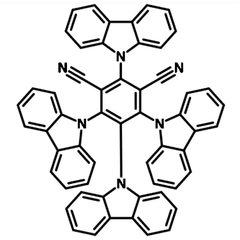
Out of its three isomers, 4CzIPN has the highest photo-luminescence quantum efficiency (PLQY) of above 90%. This is due to the wide dispersion the highest-occupied molecular orbital (HOMO) over the donor moieties. Relatively short excited-state lifetime of delayed emission was reported. Additionally, higher external quantum efficiency (EQE) was observed by using 4CzIPN as an emitter in TADF-OLED devices.
Despite its low solubility in most of the aromatic solvents, 4CzIPN is also solution-processable in solvents such as dichloromethane or chloroform. This is due to the structure distortion of the carbazole units caused by steric hindrance.
General Information
| CAS number | 1416881-52-1 |
| Chemical formula | C56H32N6 |
| Molecular weight | 788.89 g/mol |
| Absorption | λmax 365 nm in acetonitrile |
| Fluorescene | λem 551 nm in acetonitrile |
| HOMO/LUMO | HOMO = 5.8 eV, LUMO = 3.4 eV [1] |
| Synonyms | 2,4,5,6-Tetra(9H-carbazol-9-yl)isophthalonitrile |
| Classification / Family | Carbazole, TADF green emitter materials, Phosphorescent organic light-emitting devices (PHOLEDs), Sublimed materials |
Product Details
| Purity | Sublimed >99.0% (HPLC) |
| Melting point | TGA: >300 °C (0.5% weight loss) |
| Appearance | Orange-yellow powder/crystals |
*Sublimation is a technique used to obtain ultra pure-grade chemicals. For more details about sublimation, please refer to the Sublimed Materials for OLED devices page.
Chemical Structure

Device Structure(s)
| Device structure | ITO (70 nm)/(4 wt% ReO 3 ):mCP (50 nm)/mCP (15 nm)/mCP:B3PyMPM:(5 wt% 4CzIPN) (30 nm)/B3PYMPM (20 nm)/(4 wt% Rb2CO3):B3PYMPM (35 nm)/Al (100 nm) [3] |
| Colour | Green  |
| Max. Current Efficiency | 94.5 cd/A |
| Max. EQE | 29.6% |
| Max. Power Efficiency | 88.6 Im/W |
| Device structure | ITO (50 nm)/PEDOT:PSS (60 nm)/poly(9-vinylcarbazole) (15 nm)/SiCz:4CzIPN (30 nm)/TSPO1 (35 nm)/LiF (1 nm)/Al (200 nm) [4] |
| Colour | Green  |
| Max. EQE | 26% |
| Max. Power Efficiency | 63.4 Im/W |
| Device structure | ITO(130 nm)/TAPC (35 nm)/CBP (5 nm)/5 wt% 4CzIPN doped CBP (5 nm)/B4PyPPM (65 nm)/LiF (0.8 nm)/Al (100 nm) [5] |
| Colour | Green  |
| Max. Current Efficiency | 83.2 cd/A |
| Max. EQE | 25.7% |
| Max. Power Efficiency | 106.9 Im/W |
Pricing
| Grade | Order Code | Quantity | Price |
| Sublimed (>99.0% purity) | M2100A1 | 250 mg | £239.00 |
| Sublimed (>99.0% purity) | M2100A1 | 500 mg | £416.00 |
| Sublimed (>99.0% purity) | M2100A1 | 1 g | £716.00 |
MSDS Documentation
 4CzIPN MSDS sheet
4CzIPN MSDS sheet
Literature and Reviews
- Promising operational stability of high-efficiency organic light-emitting diodes based on thermally activated delayed fluorescence, H. Nakanotani et al., Sci Rep., 3: 2127 (2013); doi: 10.1038/srep02127.
- Solvent Effect on Thermally Activated Delayed Fluorescence by 1,2,3,5-Tetrakis(carbazol-9-yl)-4,6-dicyanobenzene, R. Ishimatsu et al., J. Phys. Chem. A, 117, 5607−5612 (2013); DOI: 10.1021/jp404120s.
- A Fluorescent Organic Light-Emitting Diode with 30% External Quantum Efficiency, J-W. Sun et al., Adv. Mater., 26, 5684–5688 (2014); DOI: 10.1002/adma.201401407.
- High Efficiency in a Solution-Processed Thermally Activated Delayed-Fluorescence Device Using a Delayed-Fluorescence Emitting Material with Improved Solubility, Y-J. Cho et al., Adv. Mater., 26, 6642–6646 (2014); DOI: 10.1002/adma.201402188.
- High-Performance Green OLEDs Using Thermally Activated Delayed Fluorescence with a Power Effi ciency of over 100 lmW−1, Y. Seino et al; Adv. Mater., 28, 2638–2643 (2016); DOI: 10.1002/adma.201503782.
To the best of our knowledge the technical information provided here is accurate. However, Ossila assume no liability for the accuracy of this information. The values provided here are typical at the time of manufacture and may vary over time and from batch to batch.
ebiomall.com






>
>
>
>
>
>
>
>
>
>
>









